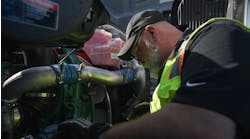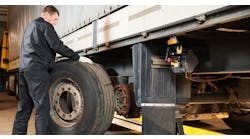While diligent preventive maintenance practices and well-trained staff can help limit roadside breakdowns, there will always be cases where mobile maintenance service is needed.
When that time comes, there are steps fleets can take to make the emergency roadside event more streamlined. Prior to a breakdown event, fleets should consider criteria for finding a qualified service provider. Then, once that roadside breakdown occurs, it is in a fleet’s best interest to prepare ahead of time for the types of details that will be required to keep the process moving.
Find a service provider
While some fleets may have their own mobile maintenance vehicles to dispatch for emergency service, many often must rely on local service providers dependent on where the breakdown occurs. Fleets can opt to work with a dedicated service provider, but may also need to reach out to a local company depending on where the disabled vehicle is located.
For dedicated routes, fleets often rely on contracted services with a specific provider or network.
“With the nature of breakdowns, even regional fleets can’t always rely on their own mechanics to get a truck back on the road in a timely fashion,” says Eric Daniels, director of shop operations for Love’s.
Love’s provides emergency roadside assistance through its fleet of 650 mobile service trucks throughout the U.S., dispatched via the company’s central call center in Oklahoma City.
Oftentimes, mobile maintenance providers will provide both contracted and one-time service for roadside assistance.
“We provide both contracted and one-off service work,” says Hillary Hansen, marketing & data mining manager, JAM Best-One Fleet Service. “Clients that have set up accounts with us benefit from streamlined billing and consistent pricing at any of the Best-One locations in our network.”
JAM Best-One Fleet Service provides commercial roadside service through its network of more than 500 service trucks at 140 service locations in the east central and southeast U.S.
If fleets are unable to connect with their contracted service provider, or in the event that the breakdown has occurred out of network, their fleets can also find a local roadside service provider through the National Truck & Trailer Services (NTTS) Breakdown Directory.
The NTTS Breakdown Directory has been printed and updated annually since 1989, and provides a comprehensive database with thousands of roadside service providers throughout the U.S. The organization has since launched a website and web-based app for tablets and smartphones, which has garnered more than 5 million searches per year. It is important to note, NTTS does not act as a mediator between the service provider and the fleet or driver.
“The nice thing about our site is it leaves all the decision making up to the truck line,” explains Shane Goebel, president, NTTS, Inc. “They choose what vendors they do business with. They coordinate the repair themselves, it’s not calling into a call center who’s only dealing with only their network of vendors. There’s certainly a place for that as well, but with our site it leaves it all up to the truck line or owner-operator to make their decisions.”
If a fleet utilizes the NTTS Breakdown Directory on a regular basis, they can save vendors and notes for future services.
“We identify the truck lines that use our site based on their public IP address,” Goebel explains. “When we identify a truck line, that then enables a notes feature so they can leave notes on the vendors they use. That notes feature is private to each company.”
While NTTS does not coordinate services, Goebel advises they will get involved with issues or complaints as necessary.
“If a truck line calls me and files a complaint on a vendor, I will call the vendor, relay it to them what happened, get their side of the story and then try to get both sides to continue to work toward a resolution,” says Goebel.
Regardless of the provider a fleet works with, the most common form of communication is still by phone. But advances continue as fleets can reach out by email or text, particularly for yard calls that are not as pressing as a roadside disabled vehicle.
For dedicated customers, Love’s has a customer interface called Shop Connect which allows fleets and drivers to submit a roadside event, and track the progress.
“In the case of our Shop Connect Customers, digital communication is provided along with their invoice,” says Daniels. “For phone customers, the fleet is notified at the time the truck is back on the road. We also have an internal app for tracking and pictures on roadside events.”
The shop contact – whether that be dispatch, the breakdown manager, maintenance manager or a technician – generally works as the liaison between the mobile maintenance provider and the driver.
In the case of fleet drivers, he or she will typically reach out to someone at the fleet to let them know a breakdown has occurred. They can also reach out to a mobile maintenance service provider directly, but especially with a fleet, that service provider should be asking follow-up information about the primary contact and decision maker for the on-site repairs once the diagnosis is completed.
Provide the details
At the time of an emergency roadside event, when the driver reaches out to the fleet or calls the provider directly, there are several pieces of information that should be provided to help make the process more efficient.
Contact information
Depending on if the driver or the fleet has called in the issue, the responding mobile maintenance provider should have the driver’s name and phone number to reach out for follow-up questions and to locate the asset. They also should have the name and contact information for the person who is the final decision maker on the repair or service.
Basic vehicle information
During the initial call to the service provider, give them the year, make and model of the truck. Other visual details that can be helpful for identifying the truck include the truck color, type of trailer (dry van, reefer, flatbed, etc.) and any other notable or distinguishing attributes.
“Know what kind of truck you’re driving, know the engine, know all the basics,” says Ray Grant, operations manager for Interstate Fleet Services. He says some drivers who have called in do not know some basic details of the vehicle they’re operating.
Based in Horsham, Pennsylvania, Interstate Fleet Services runs a fleet of 65 mobile maintenance trucks across 33 states, all operated by certified diesel technicians.
“Depending on what the problem is with the truck – if they tell me they have an air problem, I probably won’t need the engine, because it’s the compressed air system,” Grant says. “But if they tell me it’s a no-start, or they think the fuel pump is bad, of course I want to know what engine is in that truck.”
Issues with vehicle
“We don’t expect the company to know exactly what’s going on, but some information on what happened to the vehicle (is helpful), so we know how to handle it,” says Grant.
JAM Best-One Fleet Service’s Hansen suggests advising if it is mechanical in nature, and to provide specifics on noises and warning lights. Also share details on the area or system of the vehicle with issues, such as the engine, brakes, tire blowout, etc.
For tires in particular, which are a very common road call, Hansen says to provide details on the tire size, wheel position (drive, steer, trailer; inside or outside), preferred brand for replacement (new, used, retread) and what the mobile technician should do with the removed tire (for instance, take it or return it to the driver).
Taking photos with a smartphone and sending them via email or text can also provide a great visual for mobile technicians.
“The more information a driver can provide, the better,” says Love’s Daniels. “If there is visible damage to a component, pictures are always helpful as well.”
Location
Provide as much detail as possible on the location of the vehicle, including the direction headed on the interstate, nearest mile marker and notable landmarks. Give the address, if located at a physical location off the road.
“Tell me where you’re at, what do you see? I want ‘I-95, mile marker 6.’ Do you see any signs? Any McDonalds, any Burger Kings? TravelCenters of America? Do you see a bridge? We need landmarks,” says Grant.
Payment
Confirm the cost of the service call up-front, says Grant.
There are a number of different payment structures for itemized bills, but it is critical that a fleet get an estimate on cost before the service.
One of the most important things – aside from providing information to the vendors – is requesting pricing from the vendor upfront,” says NTTS’ Goebel. “It’s surprising how many people do not request that.”
When complaints are filed by fleets regarding pricing from a vendor found on the NTTS site, Goebel advises it is critical fleets have that conversation before agreeing to the service.
“If a truck line wants to file a complaint about pricing, if they didn’t get pricing up front, it’s hard for me to go to bat with them,” he says.
Details on the structure of the billing can also be helpful to understand the overall cost.
“Some companies charge for mileage, some will charge a flat rate,” says Grant. “We charge port-to-port, from the time our technician leaves to the time he gets back. We don’t bill for mileage. We just bill for the time. If you’re in a repair shop, and they’re working on your truck, they’re charging you how long it takes to work on it. We do the same thing on the road.”
Considerations should also be taken for the time date and time the service is needed.
“It can be a challenge for fleets to understand the costs associated with contracting that work to the provider. Often fleets will overpay for service after hours, on holidays and on weekends,” says Sandra Sanford, vice president, TA Truck Service RoadSquad for TravelCenters of America.
TA Truck Service offers an extensive roadside assistance network, called RoadSquad.
Arriving on the scene
The primary goal of the mobile maintenance provider is to get the vehicle up and running as soon as possible.
Grant says that 86 percent of the work completed by Interstate Fleet Services is done on-site, allowing the vehicle to return to service without the need to go to a shop for follow-up.
Goebel backs this with similar numbers, indicating “last year we fielded 1.6 million searches for truck repair, versus about 521,000 searches for towing.”
“It saves the company money when they can get it fixed and keep working, rather than tow it somewhere to a shop,” says Grant. “Chances are when a customer tows anything to a shop, it’s not going to be fixed the same day. If it’s road service, chances are you can get them going right away, they’re back to work with only a couple hours lost rather than a few days.”
Unless the breakdown is visibly so severe it will not be able to return to the road without a tow (e.g. a blown engine or dropped transmission, or significant damage to the vehicle or trailer), it is in the best interest of the fleet to contact a mobile maintenance provider to troubleshoot the issue by phone and dispatch a technician to the location for further diagnosis.
“A good service provider will troubleshoot with the fleet and/or driver to determine up front if a tow is needed, without having to send out a service truck,” TA’s Sanford says. “However, there are times when the initial repair symptoms provided do not accurately represent the true repair scope that the technician assesses when he or she arrives on the scene. In these cases, it may be in the company’s best interest to elect to have the equipment towed to a shop for more extensive service.”
When it comes to the parts needed, the mobile maintenance provider should have the part on-hand, or have a means to obtain it fairly quickly. Grant advises mobile technicians do have some parts in stock on the mobile trucks, but will not proactively purchase additional parts based on a phone-call diagnosis.
“We have a policy at our business where we go out to the scene and diagnose the issue, just because we don’t want to be buying parts and assuming anything before going out and properly diagnosing it,” Grant explains. “If your vehicle is in the shop, you wouldn’t want the dealership to start buying parts before they checked your vehicle out and tell you what’s wrong with it.”
Interstate Fleet Services outfits every mobile truck with GPS, and utilizes a third-party service provider to find the nearest location of a part, in order to pick it up and service the broke down vehicle as soon as possible.
“The diesel technician buys his own parts,” Grant explains. “We use a program called Fleetmatics, owned by Verizon. We have landmarks in there, so wherever our truck shows up on that GPS, our dispatcher can tell the technician the closest place to buy (the part).”
Sometimes, though, if the vehicle is unable to get back on the road it may need to be taken into a shop for further diagnostics or service.
“A good roadside assistance provider will also help to set up a tow if the situation warrants it,” says Sanford/TA.
Safety first
Grant advises, if at all possible, the driver should attempt to get the truck off the side of the road. “We don’t want to be on the side of the road, ever,” he says. “Sometimes we don’t have a choice, but we try to stay away from working on the side of the road.”
If it is not possible to move the vehicle, Grant says the mobile technician will attempt to get the vehicle running so they can move it to a safer location. With instances where the truck is operable, the driver has some limited flexibility on where to stop. For instance, engine and aftertreatment issues, vehicles can typically limp to an off-ramp or roadside truck stop, if not the nearest service center.
“If they tell us, ‘Oh yeah, my trucks just running hot.’ Well, it’s going to be running hot to the next exit, because we’re trying to get you off the side of the road. We don’t want to read about any of our technicians getting hit by anybody.”
The goal for any roadside service event is to get the vehicle off the side of the road, and up and running as quickly as possible.
“Unless a fleet specifically asks for a “band-aid fix” so that they can get back to their own shop to do the repairs, we will take care of whatever the issue is to get them back on the road,” JAM Best-One Fleet Service’s Hansen says.
While a fleet cannot mitigate all roadside breakdowns, they will do well to “expect the unexpected” by having procedures in place for handling unexpected events.




